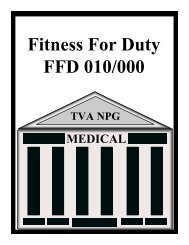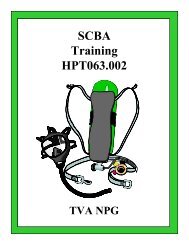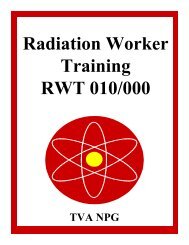The Human Performance Tool Box
The Human Performance Tool Box
The Human Performance Tool Box
Create successful ePaper yourself
Turn your PDF publications into a flip-book with our unique Google optimized e-Paper software.
Three Way<br />
Communication<br />
Basis:<br />
Mutual understanding is essential to plant<br />
operation and maintenance. <strong>The</strong>refore,<br />
responsibility for proper communication is<br />
assigned to the originator or sender, who must<br />
verify the receiver understands the message<br />
as intended. Each message that is directive in<br />
nature must use three-way communication and<br />
begins when (1st) the sender gets the attention<br />
of the intended receiver, using the person’s<br />
name, and speaks the message. <strong>The</strong>n (2nd),<br />
the receiver repeats the message in a<br />
paraphrased form, which helps the sender<br />
verify that the receiver understands the<br />
intended message. Finally (3rd), the sender<br />
acknowledges that the receiver heard and<br />
understood the message.<br />
When the receiver paraphrases the message,<br />
equipment nomenclature, identifiers, and data<br />
are repeated back exactly as spoken by the<br />
sender.<br />
<strong>The</strong> third leg of the communication is often the<br />
weak link, since the sender is tempted to not<br />
pay attention to the receiver’s statement,<br />
assuming the person heard their message. If<br />
the receiver does not receive acknowledgment<br />
from the sender, he/she should be assertive,<br />
and ask the sender to complete the third leg.<br />
Feedback is necessary to verify understanding<br />
of each spoken message.<br />
When to Use the <strong>Tool</strong>:<br />
Verbal information that is directive in nature is<br />
exchanged between people via face-to-face,<br />
telephone, or radio regarding one or more of<br />
the following:<br />
• Status of plant systems, structures, or<br />
components<br />
• Direction to perform action( action(s) on plant<br />
equipment<br />
• Work instructions, limitations and<br />
cautions.<br />
Behavior Standard:<br />
1. Using the person’s name to establish eye<br />
contact with the receiver, the sender states<br />
the message.<br />
2. Receiver acknowledges sender by<br />
paraphrasing the message in his or her own<br />
words but repeating back equipment name,<br />
UNID, and data verbatim.<br />
3. Sender verifies and acknowledges the<br />
receiver’s response is correct.<br />
4. If corrected, repeat the process.<br />
At-Risk Behaviors to Avoid:<br />
• Using slang terms instead of specific or<br />
standard terms<br />
• Sender not taking responsibility for what is<br />
said and heard<br />
• Not stating his/her name and work location<br />
(sender or receiver) when using a<br />
telephone/radio<br />
• Receiver’s name not used by the sender to<br />
get receiver’s attention<br />
• Attempting to communicate with someone<br />
already engaged in another conversation,<br />
i.e., “cross talk”<br />
• Failing to verify receiver accepted and<br />
understood the message<br />
• Message not stated clearly (such as not<br />
loudly enough or poor enunciation of words)<br />
• Receiver not verifying understanding with<br />
sender; reluctance to ask questions in a<br />
group<br />
• Speaking from behind the person intended<br />
to receive the message<br />
• Receiver does not write down message if<br />
more than two items to remember<br />
• Conflict between what is said (content of<br />
message) and the nonverbal cues of the<br />
sender.








